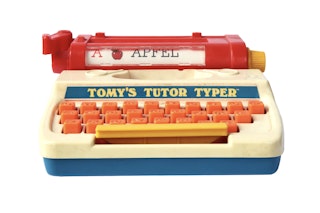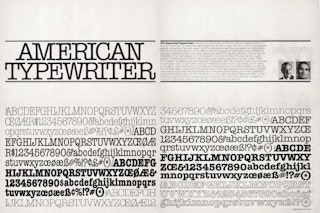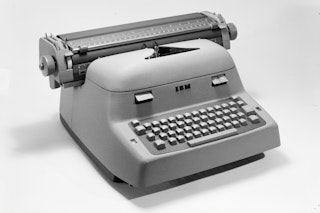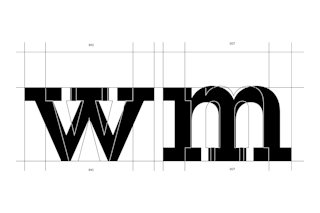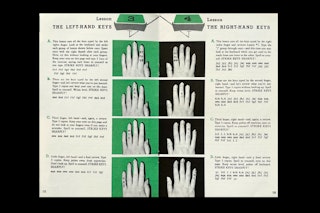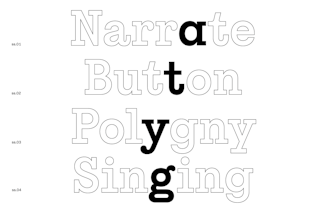Documentation
In our time, the process of writing and editing are conflated. We operate in a simultaneous process of writing and re-writing through omnipresent screens – many of us cannot relate to the struggle of taking out a new sheet of paper and inserting it into a typewriter to start over. Instead we work comfortably in the age of command-Z. With Affix, designers can pull from the essence of an earlier era combined with contemporary proportions and striking details. To be a writer (or perhaps a designer) is also to be a kind of editor – working through a constant process of selection and omission, of highlighting and crossing out, in order to let the most important moments – stand out.
In the development of letterforms for typewriters, a key part of the process was one of adaptation – designers who initially drew type for companies like IBM and Olivetti were often contractors who relied on in-house designers and engineers to adapt their drawings to production requirements. With reference to this history, it is fitting that Affix was initiated as a strict monospace set, before being reworked and finished as a proportional font, capturing the mood of these sources while rejecting their methodology. Due to their past usage, monospace typewriter fonts are embedded with a connotation of archives, libraries and systems of documentation. A range of catalogues of metal typewriter faces were examined at the onset of the project in 2019, with the goal of capturing a specific sentiment, rather than reviving a single source.
Read more →
The drawings were initiated in a rigorous process, under a nearly monolinear construction where all units were divisible by 5 and with minimal overshoot. After creating the initial fixed-pitch draft, Malte Bentzen opted to introduce an unexpected edit for this context – round geometric forms including the uppercase O, reminiscent of Futura, or perhaps more directly, ITC Lubalin Graph, Herb Lubalin and Ed Benguiat’s 1974 slab serif display family. In addition to Affix’s geometric shapes, letters normally compressed in a mono (M, m, W, w) were given breathing room, evolving from a mechanical monospace to a lively proportional family. Certain elements capture both a softness and a sharpness of the genre like the lowercase ‘c’ with its top terminal ending in a teardrop-like shape, while the bottom terminal is sharply sheared horizontally. Unique details including the diagonal moment at the top of the ’t’ add to the rhythm of the text once set. Inspired by the archives but atypical, Affix is destined to be documented.
Technical Information:
Design: Malte Bentzen
Classification: Geometric Slab Serif
Cuts: 10 (5 styles with italics)
Mastering: Michele Patanè
Cover artwork: Malte Bentzen & World Wide Web Company
First sketch: 2019
Released: 2024
Latest update: 02/2024
OpenType Features:
- aalt
- Access All Alternates
- calt
- Contextual Alternates
- case
- Case Sensitive Forms
- dnom
- Denominator
- frac
- Fractions
- liga
- Standard Ligatures
- locl
- Localized Forms
- numr
- Numerator
- ordn
- Ordinals
- pnum
- Proportional Figures
- sinf
- Scientific Inferiors
- subs
- Subscript
- sups
- Superscript
- tnum
- Tabular Figures
- ss01
- Alt a
- ss02
- Alt g
- ss03
- Alt t
- ss04
- Round dots
- ss05
- Alt y
Supported Languages:
Afrikaans, Albanian, Asu (Tanzania), Basque, Bemba (Zambia), Bena (Tanzania), Breton, Catalan, Chiga, Cornish, Croatian, Czech, Danish, Dutch, Embu, English, Esperanto, Estonian, Faroese, Filipino, Finnish, French, Friulian, Galician, Ganda, German, Gusii, Hungarian, Icelandic, Inari Sami, Indonesian, Irish, Italian, Jola-Fonyi, Kabuverdianu, Kalaallisut, Kalenjin, Kamba (Kenya), Kikuyu, Kinyarwanda, Latvian, Lithuanian, Lower Sorbian, Luo (Kenya and Tanzania), Luxembourgish, Luyia, Machame, Makhuwa-Meetto, Makonde, Malagasy, Maltese, Manx, Meru, Morisyen, North Ndebele, Northern Sami, Norwegian Bokmål, Norwegian Nynorsk, Nyankole, Oromo, Polish, Portuguese, Quechua, Romanian, Romansh, Rombo, Rundi, Rwa, Samburu, Sango, Sangu (Tanzania), Scottish Gaelic, Sena, Serbian, Shambala, Shona, Slovak, Slovenian, Soga, Somali, Spanish, Swahili (macrolanguage), Swedish, Swiss German, Taita, Teso, Turkish, Upper Sorbian, Uzbek, Volapük, Vunjo, Walser, Welsh, Western Frisian, Zulu
Buy Affix Family
Single Styles
Buying guide
We offer the possibility of buying individual styles as well as complete families. The price shown is the cost of our most basic licence. Further licencing options are available during the checkout process.
Character Overview
- Character name
- Unicode Decimal
- 65
- Unicode Hex
- 41
- HTML Entity (Hex)
- A
Uppercase
- 65A
- 66B
- 67C
- 68D
- 69E
- 70F
- 71G
- 72H
- 73I
- 74J
- 75K
- 76L
- 77M
- 78N
- 79O
- 80P
- 81Q
- 82R
- 83S
- 84T
- 85U
- 86V
- 87W
- 88X
- 89Y
- 90Z
Lowercase
- 97a
- 98b
- 99c
- 100d
- 101e
- 102f
- 103g
- 104h
- 105i
- 106j
- 107k
- 108l
- 109m
- 110n
- 111o
- 112p
- 113q
- 114r
- 115s
- 116t
- 117u
- 118v
- 119w
- 120x
- 121y
- 122z
Uppercase Accents
- 193Á
- 258Ă
- 194Â
- 196Ä
- 192À
- 256Ā
- 260Ą
- 197Å
- 195Ã
- 198Æ
- 262Ć
- 268Č
- 199Ç
- 264Ĉ
- 266Ċ
- 208Ð
- 270Ď
- 272Đ
- 201É
- 276Ĕ
- 282Ě
- 202Ê
- 203Ë
- 278Ė
- 200È
- 274Ē
- 280Ę
- 7868Ẽ
- 286Ğ
- 284Ĝ
- 290Ģ
- 288Ġ
- 294Ħ
- 292Ĥ
- 7716Ḥ
- 306IJ
- 205Í
- 206Î
- 207Ï
- 304İ
- 204Ì
- 298Ī
- 302Į
- 296Ĩ
- 308Ĵ
- 310Ķ
- 313Ĺ
- 317Ľ
- 315Ļ
- 7734Ḷ
- 321Ł
- 323Ń
- 327Ň
- 325Ņ
- 330Ŋ
- 209Ñ
- 211Ó
- 334Ŏ
- 212Ô
- 214Ö
- 210Ò
- 336Ő
- 332Ō
- 216Ø
- 213Õ
- 338Œ
- 222Þ
- 340Ŕ
- 344Ř
- 346Ś
- 352Š
- 350Ş
- 348Ŝ
- 536Ș
- 7838ẞ
- 358Ŧ
- 356Ť
- 354Ţ
- 538Ț
- 218Ú
- 364Ŭ
- 219Û
- 220Ü
- 217Ù
- 368Ű
- 362Ū
- 370Ų
- 366Ů
- 360Ũ
- 7810Ẃ
- 372Ŵ
- 7812Ẅ
- 7808Ẁ
- 221Ý
- 374Ŷ
- 376Ÿ
- 7922Ỳ
- 377Ź
- 381Ž
- 379Ż
Lowercase Accents
- 225á
- 259ă
- 226â
- 228ä
- 224à
- 257ā
- 261ą
- 229å
- 227ã
- 230æ
- 263ć
- 269č
- 231ç
- 265ĉ
- 267ċ
- 240ð
- 271ď
- 273đ
- 233é
- 277ĕ
- 283ě
- 234ê
- 235ë
- 279ė
- 232è
- 275ē
- 281ę
- 7869ẽ
- 287ğ
- 285ĝ
- 291ģ
- 289ġ
- 295ħ
- 293ĥ
- 7717ḥ
- 305ı
- 237í
- 238î
- 239ï
- 236ì
- 307ij
- 299ī
- 303į
- 297ĩ
- 309ĵ
- 311ķ
- 312ĸ
- 314ĺ
- 318ľ
- 316ļ
- 7735ḷ
- 322ł
- 324ń
- 329ʼn
- 328ň
- 326ņ
- 331ŋ
- 241ñ
- 243ó
- 335ŏ
- 244ô
- 246ö
- 242ò
- 337ő
- 333ō
- 248ø
- 245õ
- 339œ
- 254þ
- 341ŕ
- 345ř
- 347ś
- 353š
- 351ş
- 349ŝ
- 537ș
- 223ß
- 359ŧ
- 357ť
- 355ţ
- 539ț
- 250ú
- 365ŭ
- 251û
- 252ü
- 249ù
- 369ű
- 363ū
- 371ų
- 367ů
- 361ũ
- 7811ẃ
- 373ŵ
- 7813ẅ
- 7809ẁ
- 253ý
- 375ŷ
- 255ÿ
- 7923ỳ
- 378ź
- 382ž
- 380ż
Numerals
- 480
- 491
- 502
- 513
- 524
- 535
- 546
- 557
- 568
- 579
Dingbat Numerals
- 9450⓪
- 9312①
- 9313②
- 9314③
- 9315④
- 9316⑤
- 9317⑥
- 9318⑦
- 9319⑧
- 9320⑨
- 9471⓿
- 10102❶
- 10103❷
- 10104❸
- 10105❹
- 10106❺
- 10107❻
- 10108❼
- 10109❽
- 10110❾
Currency & Math
- 8383₿
- 162¢
- 164¤
- 36$
- 8364€
- 8356₤
- 8378₺
- 163£
- 165¥
- 8901⋅
- 43+
- 8722−
- 215×
- 247÷
- 61=
- 8800≠
- 62>
- 60<
- 8805≥
- 8804≤
- 177±
- 8776≈
- 126~
- 172¬
- 94^
- 8734∞
- 8709∅
- 8747∫
- 960π
- 8710∆
- 8486Ω
- 8719∏
- 8721∑
- 8730√
- 8706∂
- 181µ
- 37%
- 8240‰
Superscript
- 8304⁰
- 185¹
- 178²
- 179³
- 8308⁴
- 8309⁵
- 8310⁶
- 8311⁷
- 8312⁸
- 8313⁹
Subscript
- 8320₀
- 8321₁
- 8322₂
- 8323₃
- 8324₄
- 8325₅
- 8326₆
- 8327₇
- 8328₈
- 8329₉
Ordinals
- 170ª
- 186º
Ligatures
- 64257fi
- 64258fl
Punctuation & Symbols
- 46.
- 44,
- 58:
- 59;
- 8230…
- 33!
- 161¡
- 63?
- 191¿
- 183·
- 8226•
- 35#
- 47/
- 92\
- 40(
- 41)
- 123{
- 125}
- 91[
- 93]
- 45-
- 8211–
- 8212—
- 95_
- 8218‚
- 8222„
- 8220“
- 8221”
- 8216‘
- 8217’
- 8249‹
- 8250›
- 34"
- 39'
- 9679●
- 9675○
- 9632■
- 9633□
- 9674◊
- 64@
- 38&
- 182¶
- 167§
- 169©
- 174®
- 8471℗
- 8482™
- 176°
- 8242′
- 8243″
- 124|
- 166¦
- 8224†
- 8225‡
- 8494℮
- 65533�
Fraction
- 189½
- 8585↉
- 8531⅓
- 8532⅔
- 188¼
- 190¾
- 8533⅕
- 8534⅖
- 8535⅗
- 8536⅘
- 8537⅙
- 8538⅚
- 8528⅐
- 8539⅛
- 8540⅜
- 8541⅝
- 8542⅞
- 8529⅑
- 8530⅒
Arrows
- 8593↑
- 8599↗
- 8594→
- 8600↘
- 8595↓
- 8601↙
- 8592←
- 8598↖
- 8596↔
- 8597↕
- 11023⬏
- 11025⬑
- 8624↰
- 8625↱
- 8626↲
- 8627↳
- 11022⬎
- 11024⬐
- 8630↶
- 8631↷
- 8617↩
- 8618↪
- 8634↺
- 8635↻
- 8693⇵
- 8646⇆




